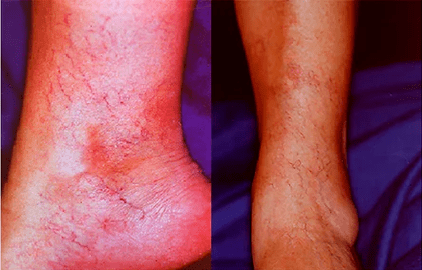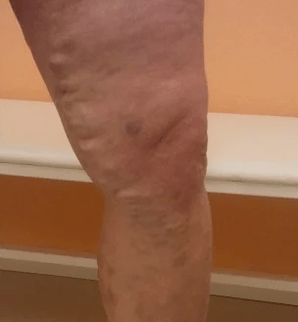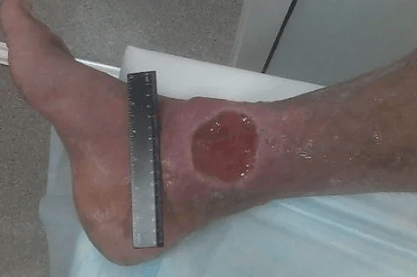
Varicose veins - This is the expansion of subcutaneous veins with a diameter of over 3 mm.Varicose veins develop due to the impaired operation of venous valves and venous wall weakness;At the same time, blood exit from the lower ends, an increase in pressure within the vein, which can lead to chronic venous insufficiency.
Sometimes the telangiectasis and the reticular veins are confused with varicose veins.
These are veins with diameter 3 mm and less, they do not affect the venous output, but cause a clear cosmetic defect.
What is the prevalence of varicose veins?
The varicose expansion of subcutaneous veins is present in 30 % of women and 15 % of men of mature age.The prevalence of varicose veins of the lower extremities increases markedly with age and is present in most people over 60.The proportion of patients with trophic disorders in adulthood is only 1.8%, while in old age the indicator reaches 20%.At the same time, every fifth patient in life comes across thrombophlebitis.Among the reasons that lead to disability, the portion of disabled veins of veins is more than arteries.
The main risk factors for the development of varicose veins are:
- elderly age
- Female gender
- pregnancy
- Hormonal disorders
- Positive Positive Family History
Additional risk factors:
- smoke
- Hypertension
- constipation
The literature on additional risk factors are contradictory.In addition, the risk of developing venous diseases is low.
How are varicose veins manifested?

The most frequent manifestation is the uneven dilated veins that projected themselves above the surface.In some cases, they can only be noticeable or determined only by touch, in others they take a winding form with the formation of us or in appearance resemble a large group of grapes.
Often, varicose veins are accompanied by the following symptoms:
- Feeling and tension in the legs
- Pain of pain and/or painful along the veins
- Fast leg fatigue
- Leg skin itch
Rarely varicose disease can cause restless leg syndrome and night cramps in the legs.
What are the dangers of varicose veins?
In the absence of treatment, varicose veins may lead to chronic venous insufficiency (CVN).The presence of HVN indicates severe violations of lymph north venous return (clinical classification of C3-C6 CEAP clinics), which include: chronic edema (lymphedem), skin color change (hyperpigmentation), venous eczema, skin compaction, trophic venous ulcer.
What are the complications of varicose veins?
Thromboflebitis-The formation of a thrombus in a venous surface system is an event that comes across 20% of patients with varicose veins.This thrombosis is accompanied by intense pain, redness of the skin, sealing along the vein in the leg and/or thigh.In the absence of treatment, thrombotic masses are possible for a deep venous system.

Deep venous thrombosis (TGV) - In most cases, the beginning of the process is asymptomatic.When thrombosis is spreading to the femoral segment and the pelvis vein, the main blood exit from the lower extremities is disturbed, which is accompanied by severe edema and pain syndrome and is considered a threatening situation of life.
Pulmonary arteries thromboembolism (screen) - In 10% of cases, thrombotic masses in deep veins of the lower extremities are fragmented and migrated to the pulmonary arteries with blood flow, causing deaths.
What is necessary for the correct diagnosis?
Given the variety of forms of vein diseases, all the details of the history of the patient's disease and life development, the presence of concomitant diseases, transactions, the result of an external examination of a doctor and most important is ultrasound, ultrasound, vein dullic ultrasound, it is important to make a diagnosis diagnosis.Today, the latter is the most accurate and non -invasive informative method of studying the veins of the lower extremities.
Treatment of varicose veins, the most common methods:
- Medicines for treatment of drug treatment have proven their effectiveness in reducing varicose veins, but are not able to eliminate varicose veins on their own.Pharmacotherapy is successfully used to avoid complications in risk groups, pre -operative preparation and postoperative rehabilitation.
- Compression treatment - Using special medical meshes in the form of golf, sock, tight pants.In some cases, multiple layers with elastic bandages of various extensions and hardware pneumo compression are used.The role of compression treatment is difficult to overestimate, is present in almost every step of preventing and treatment of chronic veins.
- Introduction to the lumen of the veins of medicines that can cause its closure.This method is a gold pattern to eliminate reticular veins.It is successfully used in the treatment of varicose veins of not a large diameter and has restrictions on the elimination of pathological blood flow of the main subcutaneous veins.
- Classic operation - Combined phlebectomy, in modern performance, is performed on an outpatient patient under spinal or local anesthesia.In some cases, this is the only viable way when target veins are very convincing and/or have high extensions.However, the method is lower than the vascular traumatic procedures.
- Endo Venous Laser Prison - A method for the treatment of varicose veins, in which the vein is not removed, but is closed from within with the laser radiation energy, which is brought directly to the wholesale vessel with a fiber.The effectiveness of the procedure is comparable to the results of surgical removal of the vein, at the same time, is characterized by minimal trauma.Rehabilitation time is 1 to 3 days.
- Radio frequency prison - A progressive way to eliminate pathological blood flow from the subcutaneous veins of the trunk.This is a completely outpatient procedure performed under local anesthesia.The effectiveness of treatment corresponds to the level of classic phlebectomy, pain syndrome is minimal or absent.Rehabilitation time is 1-2 days.












































